engine oil PONTIAC BONNEVILLE 1994 User Guide
[x] Cancel search | Manufacturer: PONTIAC, Model Year: 1994, Model line: BONNEVILLE, Model: PONTIAC BONNEVILLE 1994Pages: 290, PDF Size: 14.75 MB
Page 179 of 290
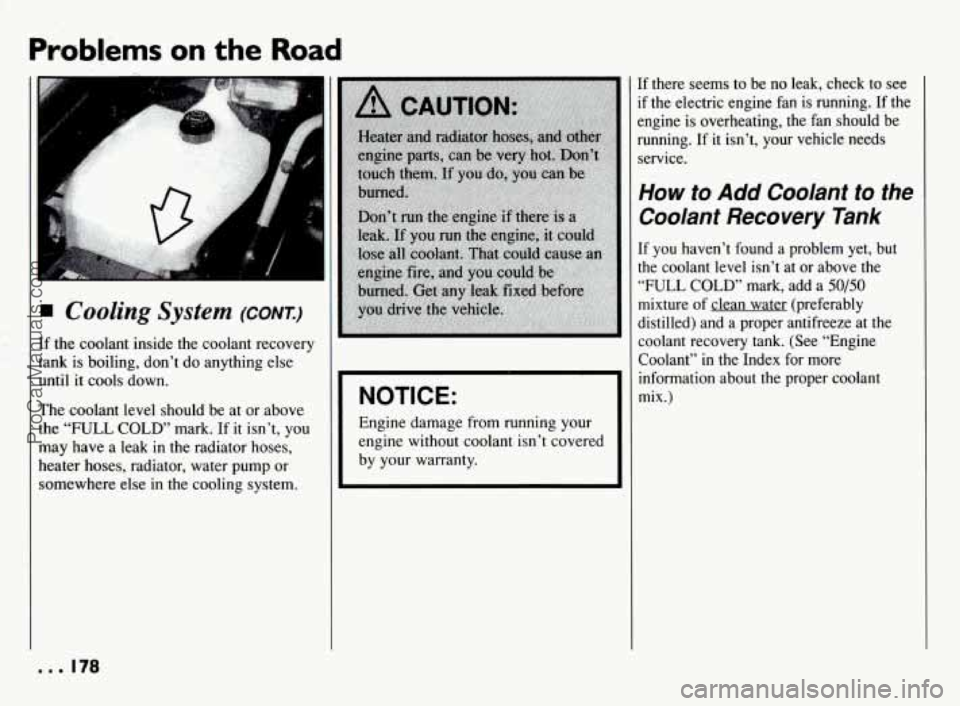
Problems on the Ro,ad
... .
I
Cooling System (CONT.)
If the coolant inside the coolant recovery
tank is boiling, don’t do anything else
until it cools down.
The coolant level should be at or above
the “FULL COLD’ mark. If
it isn’t, you
may have a leak
in the radiator hoses,
heater hoses, radiator, water pump or
somewhere else in the cooling system.
NOTICE:
Engine damage from running your
engine without coolant isn’t covered
by your warranty.
If there seems to be no leak, check to see
if the electric engine fan is running. If the
engine
is overheating, the fan should be
running. If it isn’t, your vehicle needs
service.
How to Add Coolant to the
Coolant Recovery Tank
If you haven’t found a problem yet, but
the coolant level isn’t
at or above the
“FULL COLD’ mark, add
a 50/50
mixture of clean water (preferably
distilled) and
a proper antifreeze at the
coolant recovery tank. (See “Engine Coolant”
in the Index for more
information about the proper coolant
mix.)
... 178
ProCarManuals.com
Page 197 of 290

Service & Appearance Care
MTBE is “methyl tertiary-butyl ether.”
Fuel that is no more than 15% MTBE is
fine
for your vehicle.
Ethanol is ethyl or grain alcohol.
Properly-blended fuel that is no more
than
10% ethanol is fine for your vehicle
Methanol is methyl or wood alcohol.
NOTICE:
Fuel that is more than 5% methanol
is bad for your vehicle. Don’t use it.
It can corrode metal parts
in your
fuel system and also damage plastic
and rubber parts. That damage
wouldn’t be covered under your
warranty. And even at
5% or less,
there must be “cosolvents” and
corrosion preventers
in this fuel to
help avoid these problems.
Gasolines for Cleaner Air
Your use of gasoline with deposit control
additives will help prevent deposits from
forming in your engine and fuel system.
That helps keep your engine
in tune and
your emission control system working
properly. It’s good for your vehicle, and
you’ll be doing your part for cleaner air.
Many gasolines are now blended with
oxygenates. General Motors recommends
that you use gasolines with these blending
materials, such as MTBE and ethanol. By
doing so, you can help clean the air,
especially
in those parts of the country
that have high carbon monoxide levels.
In addition, some gasoline suppliers are
now producing reformulated gasolines.
These gasolines are specially designed to
reduce vehicle emissions. General Motors recommends that you use reformulated
gasoline. By doing
so, you can help clean
the air, especially
in those parts of the
country that have high ozone levels.
You should ask your service station
operators
if their gasolines contain deposit
control additives and oxygenates, and if
they have been reformulated to reduce
vehicle emissions.
r
Countries
If you plan on driving in another country
outside the
U.S. or Canada, unleaded fuel
may ‘be hard to find.
Do not use leaded
gasoline. If you use even one
tankful, your
emission controls won’t work well
or at
all. With continuous use, spark plugs can
get fouled, the exhaust system can corrode,
and your engine
oil can deteriorate quickly.
Your vehicle’s oxygen sensor
will be
damaged. All of that means costly repairs
that wouldn’t be covered by your warranty.
To check on fuel availability, ask an auto
club,
or contact a major oil company that
does business
in the country where you’ll
be driving.
. . 196
ProCarManuals.com
Page 202 of 290
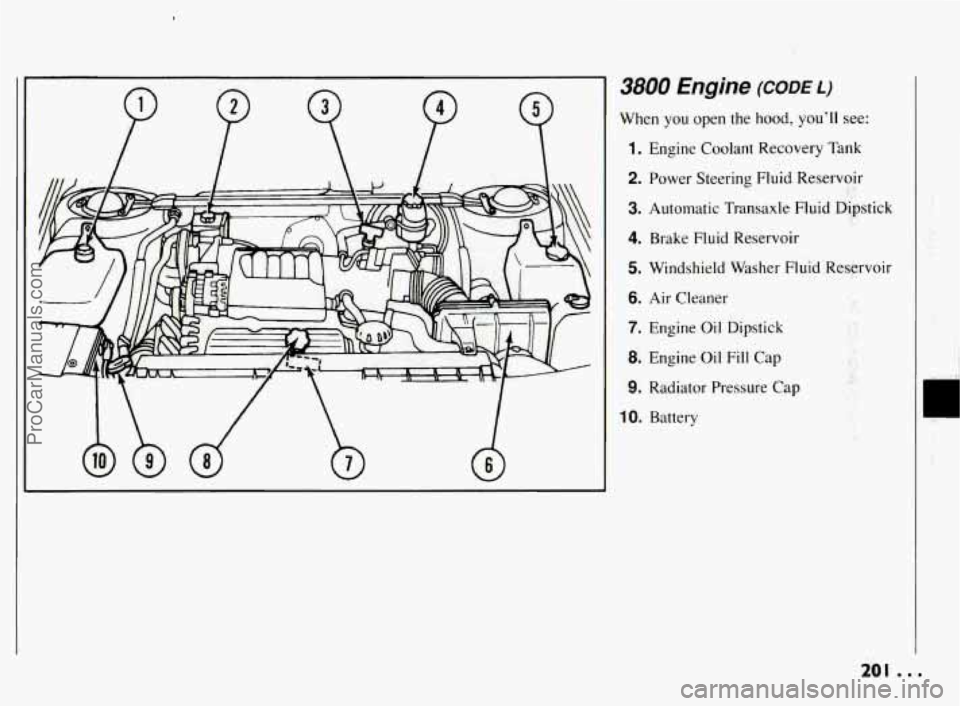
3800 Engine (CODE L)
When you open the hood, you'll see:
1. Engine Coolant Recovery Tank
2. Power Steering Fluid Reservoir
3. Automatic Transaxle Fluid Dipstick
4. Brake Fluid Reservoir
5. Windshield Washer Fluid Reservoir
6. Air Cleaner
7. Engine Oil Dipstick
8. Engine Oil Fill Cap
9. Radiator Pressure Cap
10. Battery I. .. I I 5 ;;$ " :. 1. ,.:.;
201 ..*
ProCarManuals.com
Page 203 of 290
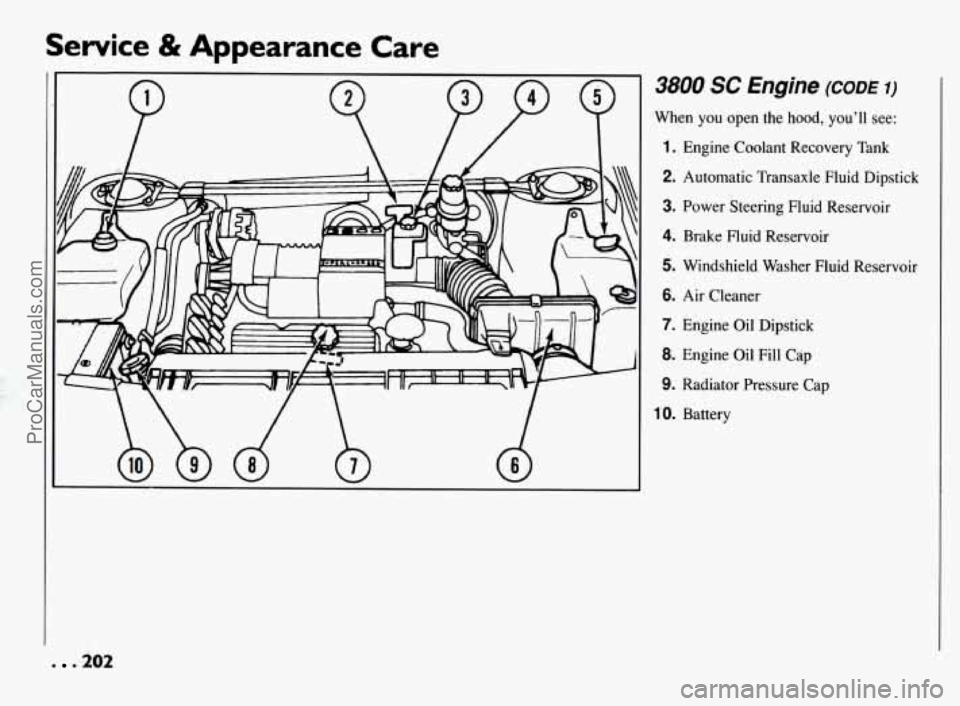
Service & Appearance Care
. 0 202
3800 SC Engine (CODE I)
When you open the hood, you’ll see:
1. Engine Coolant Recovery Tank
2. Automatic Transaxle Fluid Dipstick
3. Power Steering Fluid Reservoir
4. Brake Fluid Reservoir
5. Windshield Washer Fluid Reservoir
6. Air Cleaner
7. Engine Oil Dipstick
8. Engine Oil Fill Cap
9. Radiator Pressure Cap
lo. Battery
ProCarManuals.com
Page 205 of 290
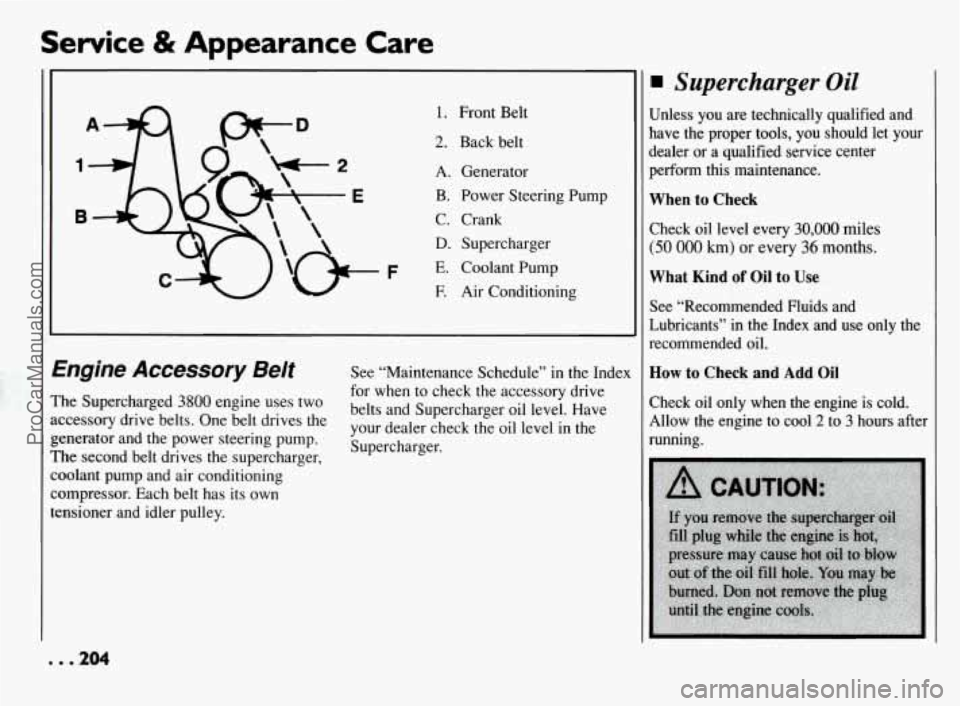
Service & Appearance Care
F
1.
2.
A.
B.
C.
D.
E.
E
Front Belt
Back belt
Generator
Power Steering Pump
Crank Supercharger
Coolant Pump
Air Conditioning
tngine Accessory Belt
‘he Supercharged 3800 engine uses two
ccessory drive belts. One belt drives the
enerator and the power steering pump.
‘he second belt drives the supercharger,
oolant pump and air conditioning
ompressor. Each belt has its own
msioner and idler pulley.
. . 204
See “Maintenance Schedule” in the Index
for when to check the accessory drive
belts and Supercharger oil level. Have
your dealer check the oil level in the
Supercharger.
Supercharger Oil
Unless you are technically qualified and
have the proper tools, you should let your
dealer or a qualified service center
perform this maintenance.
When to Check
Check oil level every 30,000 miles
(50 000 km) or every 36 months.
What Kind of Oil to Use
See “Recommended Fluids and
Lubricants” in the Index and use only the
recommended oil.
How to Check and Add Oil
Check oil only when the engine is cold.
Allow the engine to cool
2 to 3 hours after
running.
ProCarManuals.com
Page 206 of 290
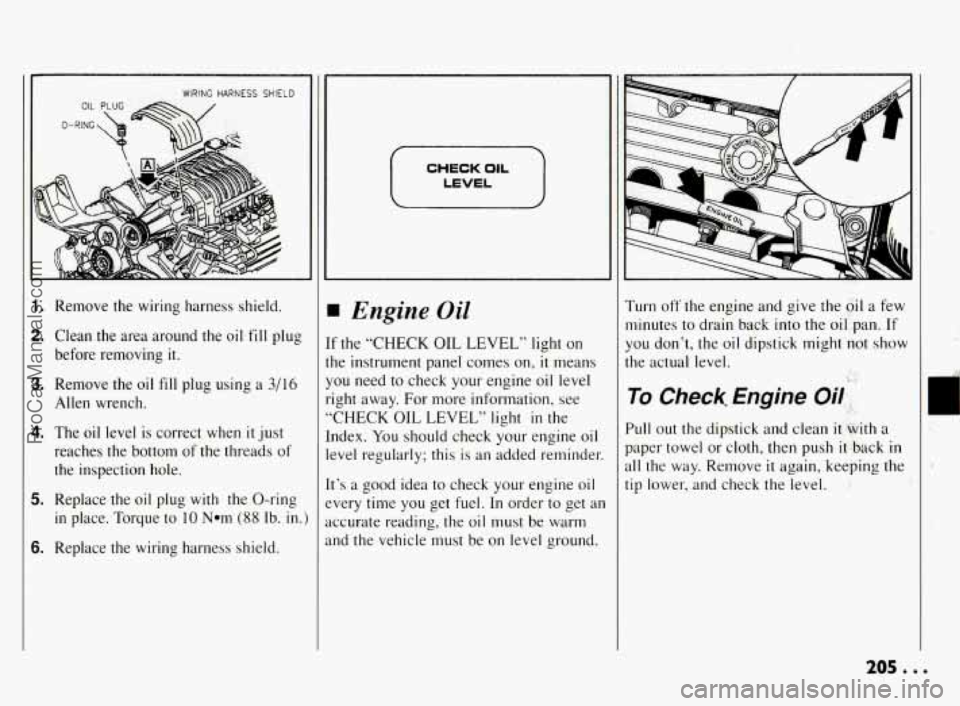
WIRING HARNESS SHIELD I
Remove the wiring harness shield.
Clean the area around the oil
fill plug
before removing it.
Remove the oil fill plug using a
3/16
Allen wrench.
The oil level is correct when
it just
reaches the bottom of the threads
of
the inspection hole.
Replace the oil plug with the O-ring
in place. Torque to
10 Nom (88 Ib. in.)
Replace the wiring harness shield.
I
I
tl
Y
r
6
1f
I1
e
a
LC
a
CHECK OIL
LEVEL
Engine Oil
f the “CHECK OIL LEVEL” light on
he instrument panel comes on,
it means
‘ou need to check your engine oil level
ight away. For more information, see
CHECK OIL LEVEL” light
in the
ndex.
You should check your engine oil
:vel regularly; this is an added reminder.
t’s a good idea to check your engine oil
very time you get fuel. In order
to get an
ccurate reading, the oil must be warm
nd the vehicle must be on level ground. Turn off the engine and
give
the oil a few
minutes to drain back into the
oil pan. If
you don’t, the oil dipstick might not show
the actual level.
To Check, Engine Oil ., I’ .
Pull out the dipstick and clean it %with a
paper towel or cloth, then push
it back in
all the way. Remove
it again, keeping the
tip lower, and check the level.
r
205 .
ProCarManuals.com
Page 207 of 290
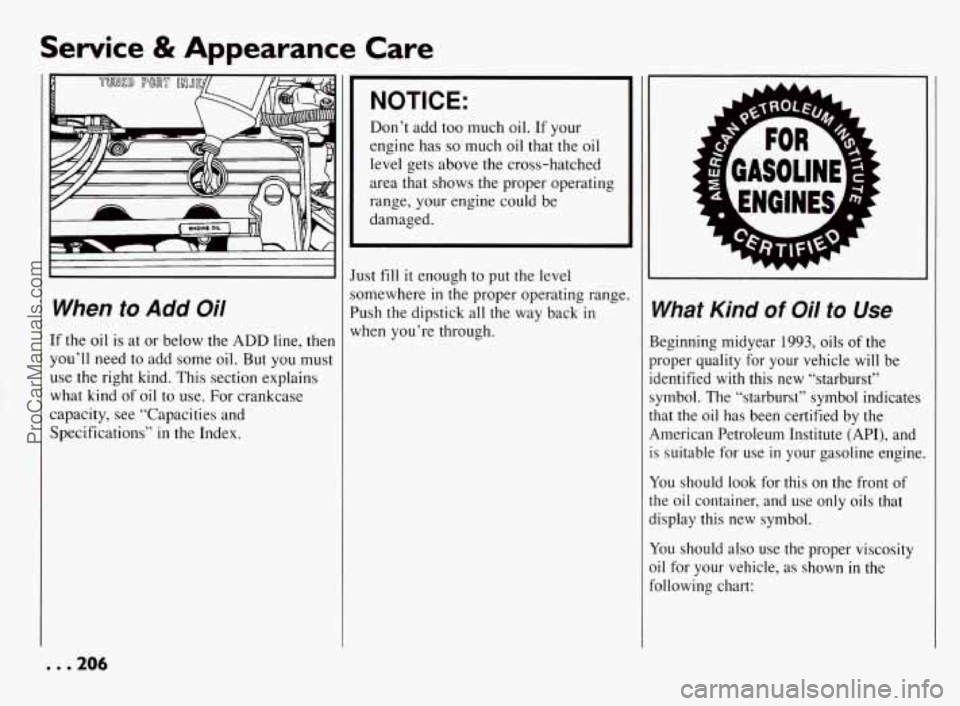
Service & Appearance Care
When to Add Oil
If the oil is at or below the ADD line, then
you’ll need to add some oil. But you must
use the right kind. This section explains
what kind of oil to
use. For crankcase
capacity,
see “Capacities and
Specifications” in the Index.
, . .206
NOTICE:
Don’t add too much oil. If your
engine has
so much oil that the oil
level gets above the cross-hatched
area that shows the proper operating
range, your engine could be
damaged.
Just fill it enough to put the level
somewhere in the proper operating range.
Push the dipstick all the way back in
when you’re through.
What Kind of Oil to Use
Beginning midyear 1993, oils of the
proper quality for
your vehicle will be
identified with this new “starburst”
symbol. The “starburst” symbol indicates
that the oil has been certified by the
American Petroleum Institute (API), and is suitable for use
in your gasoline engine.
You should look for this on the front of
the
oil container, and use only oils that
display this new symbol.
You should also use the proper viscosity
oil for your vehicle,
as shown in the
following chart:
ProCarManuals.com
Page 208 of 290
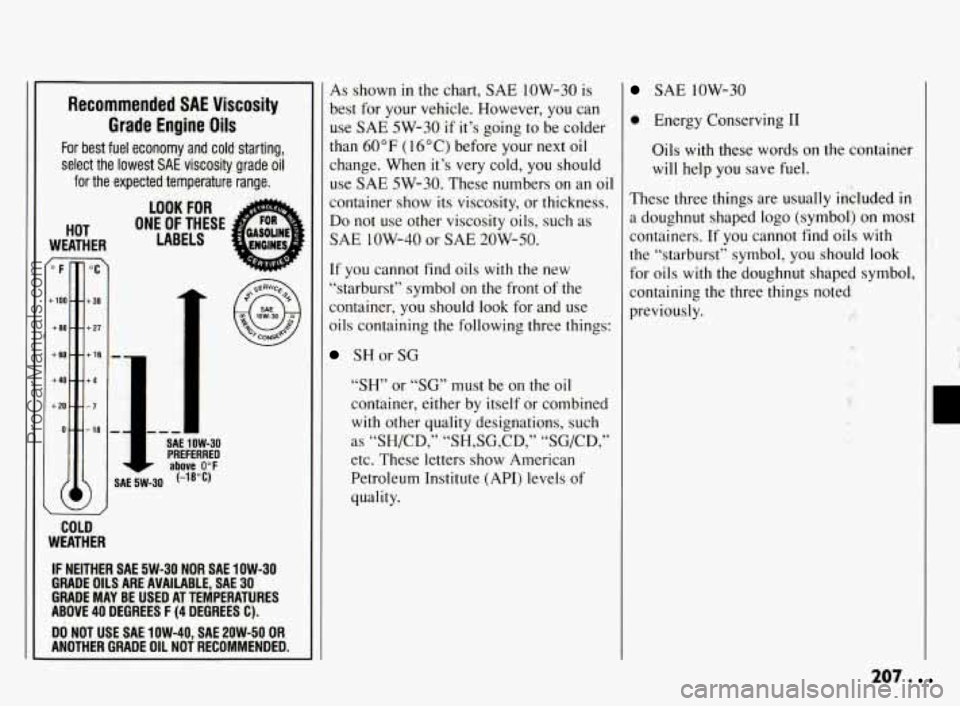
Recommended SAE Viscosity
Grade Engine Oils
For best fuel economy and cold starting,
select the lowest
SAE viscosity grade oil
for the expected temperature range.
LOOK FOR fi
HOT ONE OF THESE -. FOR ~
WEATHER LABELS
P c
-
-
SAE 1 OW-30 PREFERRED
SAE 5W-30
IF NEITHER SAE 5W-30 NOR SAE 1OW-30
GRADE OILS ARE AVAILABLE, SAE
30
GRADE MAY BE USED AT TEMPERATURES
ABOVE 40 DEGREES
F (4 DEGREES C).
ANOTHER GRADE OIL NOT RECOMMENDED.
DO
NOT USE
SAE 1OW-40, SAE 2OW-50 OR
As shown in the chart, SAE 1OW-30 is
best for your vehicle. However, you can
use SAE 5W-30
if it’s going to be colder
than 60°F (16°C) before your next oil
change. When it’s very cold, you should
use SAE 5W-30. These numbers on an oil
container show its viscosity, or thickness.
Do not use other viscosity oils, such as
SAE 1OW-40 or SAE
20W-50.
If you cannot find oils with the new
“starburst” symbol on the front of the
container, you should
look for and use
oils containing the following three things:
SHor SG
“SH” or “SG’ must be on the oil
container, either by itself or combined
with other quality designations, such
as “SH/CD,” “SH,SG,CD,” “SG/CD,”
etc. These letters
show American
Petroleum Institute (API) levels of
quality.
SAE low-30
0 Energy Conserving I1
Oils with these words on the container
will help you save fuel.
These three things are usually included in
a doughnut shaped logo (symbol) on most
containers. If you cannot find oils
with
the “starburst” symbol, you should look
for oils
with the doughnut shaped symbol,
containing the three things noted
previously.
C
207.
ProCarManuals.com
Page 209 of 290
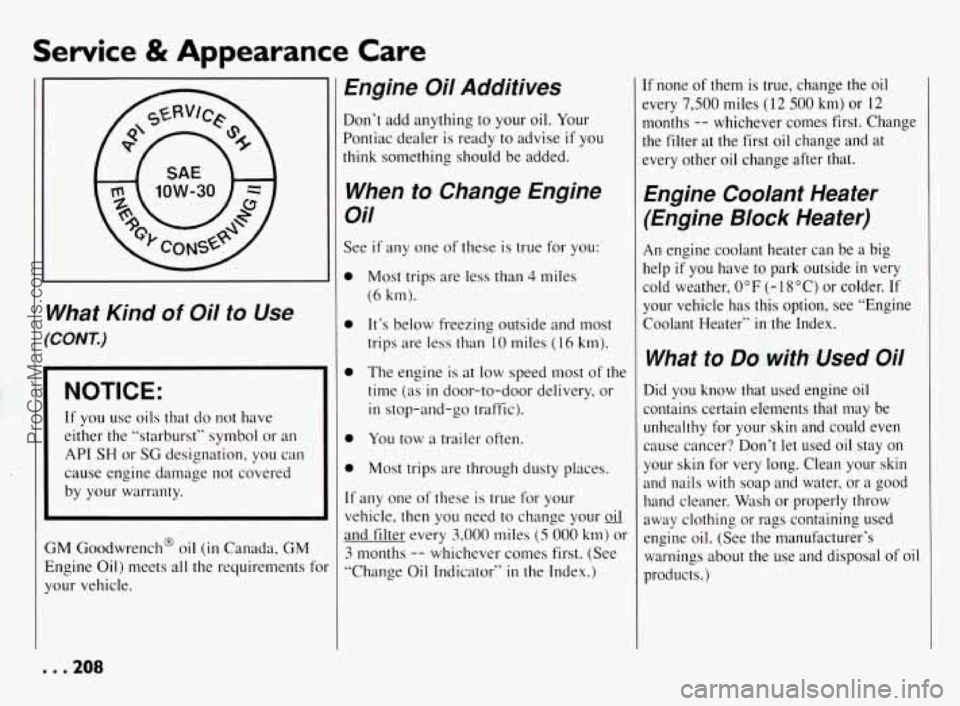
Service & Appearance Care
What Kind of Oil to Use
‘CONT.)
NOTICE:
If you use oils that do not have
either the “starburst” symbol or an
API SH or SG designation, you can
cause engine damage not covered
by
your warranty.
GM Goodwrench@ oil (in Canada, GM
Engine Oil) meets all the requirements fc
your vehicle.
Engine Oil Additives
I Don‘t add anything to your oil. Your
Pontiac dealer is ready
to advise if you
[hink something should be added.
When to Change Engine
Oil
See if any one of these is true for you:
0 Most trips are less than 4 miles
(6 km).
0 It’s below freezing outside and most
trips are less than
10 miles (16 km).
0 The engine is at low speed most of the
time (as
in door-to-door delivery, or
in stop-and-go traffic).
0 You tow a trailer often.
0 Most trips are through dusty places.
If any one of these is true for your
vehicle, then you need
to change your giJ
and filter every 3,000 miles (5 000 km) or
3 months -- whichever comes first. (See
“Change Oil Indicator”
in the Index.)
If none of them is true, change the oil
every
7,500 miles ( 12 500 km) or 12
months -- whichever comes first. Change
the filter at the first oil change and
at
every other oil change after that.
Engine Coolant Heater
(Engine Block Heater)
An engine coolant heater can be a big
help
if you have to park outside in very
cold weather,
0°F (-ISOC) or colder. If
your vehicle has this option, see “Engine
Coolant Heater”
in the Index.
What to Do with Used Oil
Did you know that used engine oil
contains certain elements that may be
unhealthy for your skin and could even
cause cancer‘? Don’t let used oil stay
on
your skin for very long. Clean your skin
and nails
with soap and water, or a good
hand cleaner. Wash or properly throw
away clothing or rags containing used
engine oil. (See the manufacturer’s warnings about the use and disposal of oil
products.)
. . .208
ProCarManuals.com
Page 210 of 290
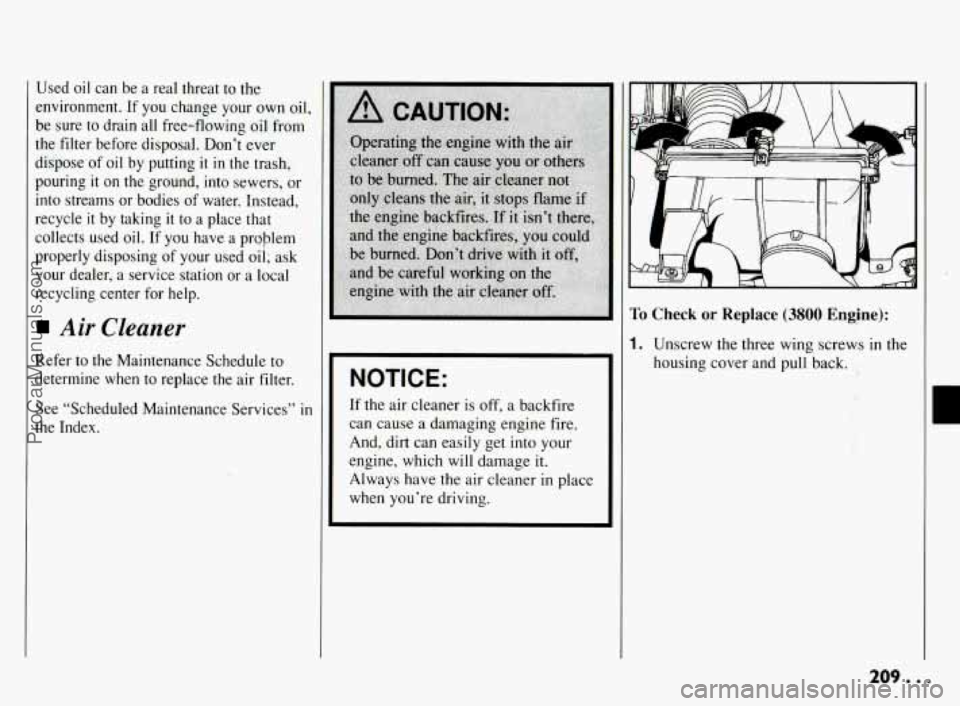
Used oil can be a real threat to the
environment. If you change your own oil,
be sure to drain all free-flowing oil from
the filter before disposal. Don’t ever
dispose of oil by putting
it in the trash,
pouring it on the ground, into sewers, or
into streams or bodies of water. Instead,
recycle
it by taking it to a place that
collects used oil.
If you have a proplem
properly disposing of your used oil; ask
your dealer, a service station or a local
recycling center for help.
Air Cleaner
Refer to the Maintenance Schedule to
determine when to replace the air filter.
See “Scheduled Maintenance Services” in
the Index.
NOTICE:
If the air cleaner is off, a backfire
can cause a damaging engine fire.
And, dirt can easily get into your
engine, which will damage it.
Always have the air cleaner in place
when you’re driving.
To Check or Replace (3800 Engine):
1. Unscrew the three wing screws in the
housing cover and pull back.
t
209.. .
ProCarManuals.com